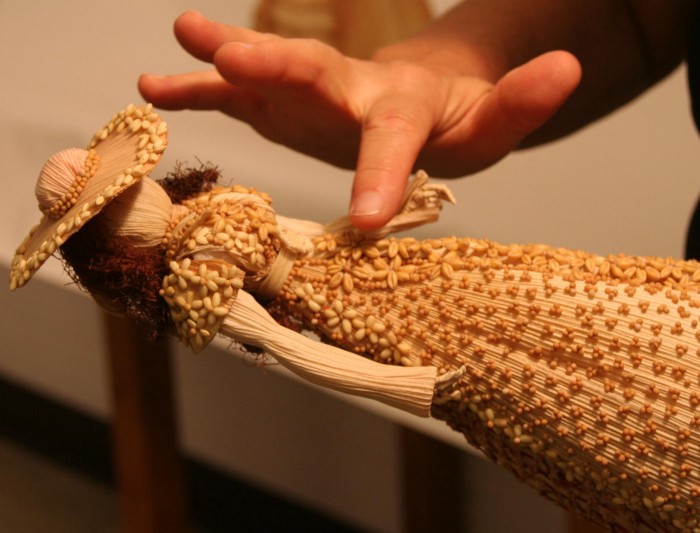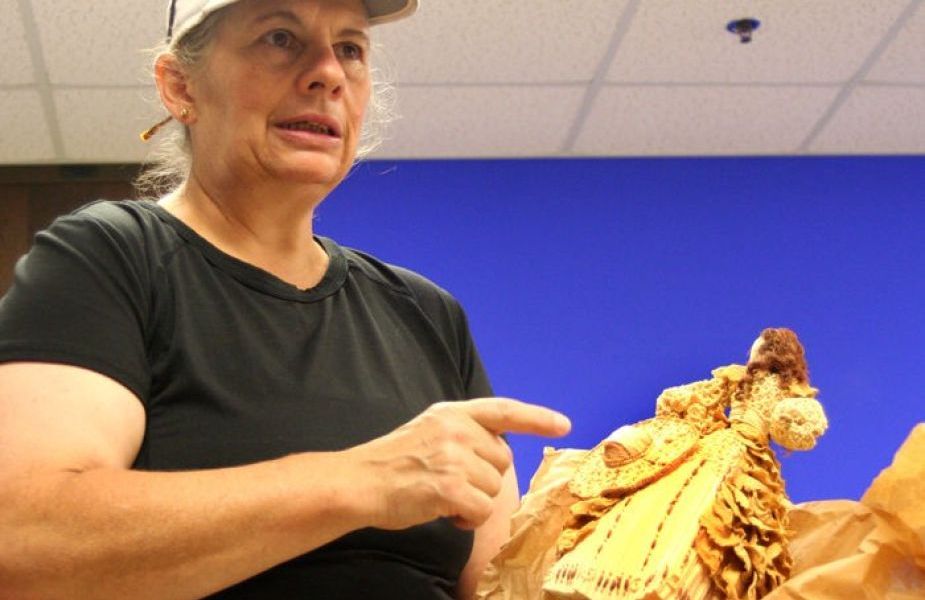HUNTINGTON, W.Va. — Growing up in upstate New York, Christine Ingersoll was surrounded by cornfields. So her passion for crafting elegant corn husk dolls may seem an appropriate, if not a de facto, extension of her childhood environment.
But she’d beg to differ.
“If you would have ever asked me if I’d make corn husk dolls, I would have giggled,” Ingersoll said. “I don’t see myself as a doll person or a sewer or a craftsy kind of person at all.”
So it was a bit of surprise when, after seeing an article on how to construct traditional corn husk dolls in a craft magazine, she fell in love with the past time.
“I just played with it and made one,” Ingersoll said. “I’ve made them ever since.”
Like many of her corn husk crafting counterparts, her first dolls resembled traditional, pioneer-themed creations. But as her interest in the craft grew, so did the look of her dolls.
From her desk in her office at Marshall University in Huntington, W.Va., the assistant professor of advertising displayed photos of her intricately embellished work. In one photo, a colonial doll with a tricorn hat is dressed in a flowing, multi-layered red dress. In another, a Slovakian-inspired doll, bearing rose petals as its base, is adorned with an ornate bonnet and intricately patterned dress cover. In a third photo, an angel doll’s dress is made all the more detailed with its flowing, bowed train.
What started as mere leisurely craft, Ingersoll said, has turned into much more. Twenty years of experimentation have led her to a more refined process. No longer are the dolls simply craft to her, she said. Now she considers them art.
“I remember the turning point when my dolls finally went from just being corn husk dolls to being art I was incredibly proud of,” Ingersoll said. “I don’t think I really truly made art until maybe five years ago.”
Ingersoll has built a career around her creative side — though not necessarily of doll making. In college, she obtained degrees in drawing and advertising. As a professor at Marshall, she guides advertising students in creating dynamic and visually appealing messages.

“I guess you could call me an artist,” Ingersoll said. “I see myself more as a designer.”
While her work is on display and for sale in West Virginia’s showcase arts center, Tamarack in Beckley, Ingersoll said she has no desire to make a solo career from doll making.
“I just make them as art, like a painter sits to paint,” Ingersoll said. “But if you’re not inspired to paint, you don’t paint. What I make is what I make, and that’s it.
The process of making each doll, each of which find their inspiration in historically and culturally accurate research, is detailed and often time-consuming. All parts of her dolls are made from natural materials, except for the wire and paper structure that forms the base of her creations. Everything is formed by hand, and she places each embellishment on her dolls piece by piece.
“That’s what I like about making them,” Ingersoll said. “I try to constantly think of ways to challenge the corn husk.”
Ingersoll said she finds the natural materials during her hikes and in the bulk bins at natural food stores. Mustard seed, barley and rose petals are just some of the items used in her pieces. The natural embellishments she chooses for each doll depend on the look she’s going for.
"It's like painting," Ingersoll said. "You pick the right color for the thing."
Ingersoll said one of her next projects is to create a West Virginia-inspired doll.
“When I was at Tamarack for my first interview … I thought, ‘I’d like to try a doll that has the essence of West Virginia,’” Ingersoll said. That’s where she got the idea to make a doll using Pearl S. Buck, the Hillsboro-born author, as a starting point.
One of the things that make Ingersoll’s dolls unique is the amount of detail that goes into them.
“When [people] see all this detail, they’re always overwhelmed because they know it probably took hours and hours,” Ingersoll said.
Indeed, each doll Ingersoll makes takes several days — if not months — to finish.
“Sometimes I’ll start making a doll and it doesn’t look right, and I’ll put it aside and I’ll go back to it,” Ingersoll said. “I’ve got a couple of little dolls that are sitting there that have probably sat there a year, and I’ve never went back to them because they just weren’t working.”
In all, Ingersoll said she has made hundreds of dolls — most of which have been unique in style and presentation.
Ingersoll said the best part of making the dolls is seeing the expressions on the faces of those who see her work.
“When people look at them they get all excited,” Ingersoll said. “I don’t know, I think all of us artists have huge egos and we like people to like what we do.”

